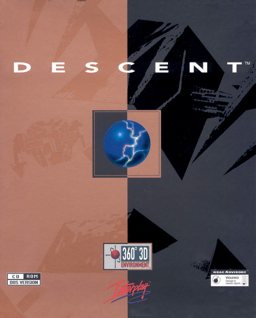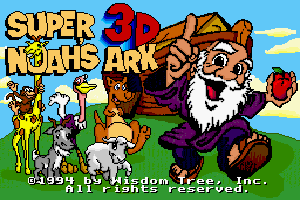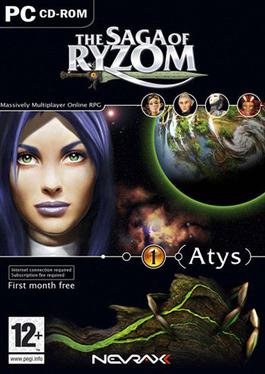
Duke Nukem 3D is a first-person shooter video game developed by 3D Realms. It is a sequel to the platform games Duke Nukem and Duke Nukem II, published by 3D Realms.

Rise of the Triad: Dark War is a first-person shooter video game, developed and published by Apogee Software in 1995. The player can choose one of five different characters to play as, each bearing unique attributes such as height, speed, and endurance. The game's story follows these five characters who have been sent to investigate a deadly cult, and soon become aware of a deadly plot to destroy a nearby city. Its remake was designed by Interceptor Entertainment and released by Apogee Games in 2013. The shareware version of the game is titled Rise of the Triad: The HUNT Begins.

Descent is a first-person shooter (FPS) game developed by Parallax Software and released by Interplay Productions in 1995 for MS-DOS, and later for Macintosh, PlayStation, and RISC OS. It popularized a subgenre of FPS games employing six degrees of freedom and was the first FPS to feature entirely true-3D graphics. The player is cast as a mercenary hired to eliminate the threat of a mysterious extraterrestrial computer virus infecting off-world mining robots. In a series of mines throughout the Solar System, the protagonist pilots a spaceship and must locate and destroy the mine's power reactor and escape before being caught in the mine's self-destruction, defeating opposing robots along the way. Players can play online and compete in either deathmatches or cooperate to take on the robots.

The NewZealand Story is a platform game developed and released in arcades by Taito in 1988. The concept and setting were inspired by a holiday trip in New Zealand by one of the Taito programmers. The player controls Tiki (ティキ), a kiwi who must save his girlfriend Phee Phee (ピューピュー) and several of his other kiwi chick friends who have been kidnapped by a large blue leopard seal. While avoiding enemies, the player has to navigate a scrolling maze-like level, at the end of which they release one of Tiki's kiwi chick friends trapped in a cage. In 2007, the arcade game received a remake for the Nintendo DS under the title New Zealand Story Revolution.
An action game is a video game genre that emphasizes physical challenges, including hand–eye coordination and reaction time. The genre includes a large variety of sub-genres, such as fighting games, beat 'em ups, shooter games, rhythm games and platform games. Multiplayer online battle arena and some real-time strategy games are also considered action games.

Super 3D Noah's Ark is a Christian video game developed by Wisdom Tree for the Super Nintendo Entertainment System, and was ported a year later to MS-DOS, and re-released in 2015 on Steam for Microsoft Windows, Mac OS X, and Linux. The game was an officially licensed id Software Wolfenstein 3D engine title, but was not licensed by Nintendo, so it was sold in Christian bookstores instead of typical video game retailers.

Blood is a 3D first-person shooter video game developed by Monolith Productions and published by GT Interactive and developed using Ken Silverman’s Build engine. The shareware version was released for MS-DOS on March 7, 1997, while the full version was later released on May 21 in North America, and June 20 in Europe.

Shadow Warrior is a first-person shooter video game developed by 3D Realms and published by GT Interactive. The shareware version was released for the PC on May 13, 1997, while the full version was completed on August 25, 1997 and released in stores on September 16, 1997. Shadow Warrior was developed using Ken Silverman's Build engine and improved on 3D Realms' previous Build engine game, Duke Nukem 3D. Mark Adams ported Shadow Warrior to Mac OS in August 1997.

Ryzom, also known as The Saga of Ryzom, is a free and open source massively multiplayer online role-playing game (MMORPG) developed by Nevrax for Microsoft Windows, OS X, and Linux.

Witchaven is a dark fantasy first-person shooter video game developed by Capstone Software and published by Intracorp Entertainment in 1995. Its sword-and-sorcery themed story tasks the knight Grondoval with a quest to seek out and destroy a lair of witches in their titular fortress, fighting hordes of hostile monsters along the way. Witchaven features action role-playing elements such as leveling, as well as an emphasis on melee combat. Its code was based upon an early version of the nascent Build engine. The game received overall mixed reviews, such as praise for its atmosphere and gory combat, but criticism for some aspects of gameplay. It was followed by a sequel titled Witchaven II: Blood Vengeance in 1996.

3D Lemmings is a 1995 puzzle video game developed by Clockwork Games and published by Psygnosis. The gameplay, like the original Lemmings game, requires the player to lead all the lemmings to their exit by giving them the appropriate "skills". It was the first Lemmings game to be rendered in 3D. It was released for DOS, PlayStation, and Sega Saturn.

Raptor: Call of the Shadows is a vertically scrolling shooter developed by Cygnus Studios and published by Apogee Software. Its working title was "Mercenary 2029". It was released on April 1, 1994 for MS-DOS compatible systems. The first episode of the game, "Bravo Sector", was distributed as shareware. The other two episodes were sold commercially.

Cave Story is a 2004 Metroidvania platform-adventure video game for Microsoft Windows. It was developed over five years by Japanese independent developer Daisuke "Pixel" Amaya in his free time. Cave Story features 2D platform mechanics and is reminiscent of the games Amaya played in his youth, such as Metroid and Castlevania. After its initial self-published release, the game slowly gained popularity on the internet. It received widespread critical acclaim for many polished aspects of its design, such as its compelling characters, setting, story, and gameplay. Cave Story is considered by many as the quintessential indie game because of its one-person development team and influence on the video gaming world.

PowerSlave, known as Exhumed in Europe and 1999 AD: Resurrection of the Pharaoh in Japan, is a first-person shooter video game developed by Lobotomy Software and published by Playmates Interactive Entertainment in North America, and BMG Interactive in Europe and Japan. It was released in North America, Europe and Japan, for the Sega Saturn, PlayStation, and MS-DOS over the course of a year from late 1996 to late 1997. On May 24, 2015, Powerslave EX, an unofficial remake of the PlayStation version appeared on GitHub. The MS-DOS version of PowerSlave was added to the GOG store on November 19, 2020.

Bio Menace is a 1993 game developed and published by Apogee Software for MS-DOS. A 2D multidirectional scrolling platform game, it was built on a licensed version of id Software's Commander Keen game engine. Apart from the engine and music, all in-game content was created by the game's designer, Jim Norwood. In 2014, the game was re-released on Steam, and in 2015 on GOG.com with support for Microsoft Windows, macOS, and Linux.
Gradius is a series of shooter video games, introduced in 1985, developed and published by Konami for a variety of portable, console and arcade platforms. In many games in the series, the player controls a ship known as the Vic Viper.

Avatar: The Game is a third-person action video game based on James Cameron's film Avatar. The game was developed by Ubisoft Montreal and released on the PlayStation 3, Xbox 360, Microsoft Windows, Wii and Nintendo DS on December 1, 2009, with a PSP version later released on December 7. It uses the same technology as the film to be displayed in stereoscopic 3D. As of May 19, 2010, the game has sold nearly 2.7 million copies. It was followed by a second video game released for the franchise titled Avatar: Frontiers of Pandora (2023).

Battleship: Surface Thunder is a PC video game developed by Meyer/Glass Interactive and published by Hasbro Interactive. It was released in the United States on September 12, 2000. The game is split into two modes: the regular classic battleship and a new arcade version that expands on the classic game in the form of a mission-based third-person shooter.

Shadow Warrior is a 2013 first-person shooter game developed by Flying Wild Hog and published by Devolver Digital. The game is a reboot of the 1997 original of the same name, developed by 3D Realms and published by GT Interactive, licensed out by Devolver Digital. It features the same character Lo Wang and a modern era setting with Asian mythology elements, all of which were redesigned with modern, full 3D graphics and new gameplay features, while also being a throwback to classic first-person shooters.

Wrath: Aeon of Ruin is a first-person shooter developed by KillPixel Games and Slipgate Ironworks and published by 3D Realms and Fulqrum Publishing. Wrath: Aeon of Ruin is built on a modified version of the Quake engine, making it the first major game release on that engine in nearly 20 years. The first episode was released on Steam Early Access on November 22, 2019, and was fully released on February 27, 2024.


















